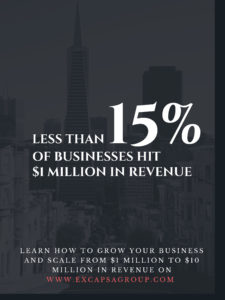Hitting the million dollar stage in your business is a chance that’s literally almost one in a million. It’s an exceptional benchmark, especially considering approximately less than 15% of small businesses make it this far. This is something to congratulate yourself on, as you’ve delivered a sustainable model that’s proven to work. However, don’t celebrate too much because as the old saying goes, getting there is easy, keeping it is the hard part.
Maintaining Success
Now that you’ve reached a million, the first thing you need to look at is your business’s needs to continue growing. While we all get excited over the idea of having a swanky new office with exposed brick and an in-house kitchen, those aren’t always feasible, even with extra revenue.
Instead, it’s important to consider how every investment you make from this point forward will maximize your ROI, as well as keep a consistent product and company culture. When it comes to employees, consider the types of roles you’re trying to hire for and what the long-term need is for each. For example, while you may want some creative or design work done, bringing on a contractor or freelance might be more advantageous than having some in-house. As Dave Kerpen notes, it’s best to “hire slow, fire fast.” That is, if you’re looking to build a culture, these decisions take time, but in the long run, will save you a tremendous amount of turnover.
Another factor to consider in new spending is the cost/benefit analysis of acquiring new equipment. While some of us may think that upgrading or expanding our current inventory will always increase productivity and efficiency, consider how much more will be produced, the amount of staff it will take, and how much training is involved as well. Sure, new equipment is something everyone wants, but maximize your dollar on it before anything else.
 Let It Grow
Let It Grow
With the sustained revenue you’ve acquired, it’s important to start considering pushing your product further. While considerably a luxury for some businesses, spending money on advertising could potentially be a necessity for you now.
This is the time to hone in and really develop your brand’s story. After all, new customers that are going to be learning about your company are going to want to know what you’re about, as well as if it’s something they should hold loyalty to. Being successful could also mean the difference between a one-time sale and a lifetime customer.
Perhaps you’re already off to a good start via either traditional advertising or social media, but it’s time to start strategizing how to bring these together in a pipeline. While there are hundreds of avenues you could go down (I.E.: PPC, SEO, Content Strategy, Print, Video, etc.), your pipeline should have a starting point (a social media post, blog link, etc.) that eventually leads to an action (customer signup, a sale, newsletter signup, appointment, etc).
Finally, another important element of promoting your business is working more closely with those in your local community as well as your industry. Partner with those who you think could host a symbiotic relationship that will drive sales for both.
Inventing the Future
This final section is a textbook growth strategy, but it needs to be reiterated: keep doing what you’re good at. While it sounds silly, a lot of businesses are destined for failure because they listen to themselves more than what their customers/market are telling them. However, when it comes to expansion, that same source is also where they need to look.
Your customers are more than likely already giving you feedback on how to improve your product (or, are willing to), and that’s something you should not just hear, but listen to. Additionally, take the time to compile the data necessary to see where expansion would be most lucrative.
I know most of us would like to be innovators or “the next Apple,” but the primary source where you’re going to “get ahead of the curve” is going to be straight from the people already buying your product.
Finally, when it comes to new products, follow the model of experimenting, testing, and deploying when ready. It’s never advantageous to overextend and put all your chips in one basket, especially on something that could potentially bankrupt your business. Remember, the goal is to push the bar while remaining relevant. Do that, and you’ll be earning $10 million quicker than you hit your first million.

